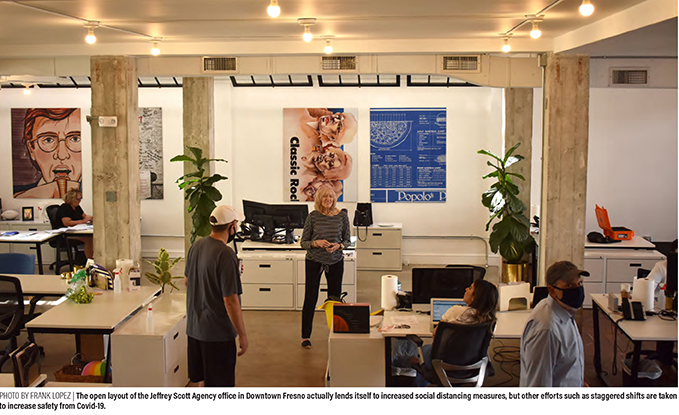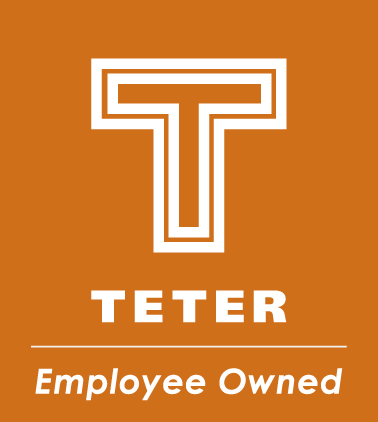 Clay Davis, Partner & Architect, provides insight into the future of office design
Clay Davis, Partner & Architect, provides insight into the future of office design
Originally printed in The Business Journal on June 26, 2020 by Frank Lopez
If you weren’t aware of it before, the spread of the coronavirus has probably made you more spatially aware.
The workplace is marked with new physical and material distancing measures, whether it is in offices, industrial or medical facilities — virtually every worksite in operation. Then there are facial covering requirements, limited building capacities, guidance stickers on floors, space dividers and daily sanitization.
The pandemic is also upending some architectural and design trends that were increasing in popularity even up until the onslaught of COVID-19.
For sometime now, companies and offices have been investing in open floor-plan offices, with less cubicles and private offices, and more coworking spaces and large conference tables where employee interaction was encouraged—its easy to see why this could be a problem in a post-COVID-19 world.
At Facility Designs, an interior design firm in Fresno that specializes in office workspaces, Account Executive Cassie Weibert and Director of Operations Carrie De Young have the task of helping clients make the most of their space in a world going through a pandemic.
Weibert and De Young noted that not all businesses will have the space or capital to create physical barriers, so changes in behavior are just as important as material changes. Some of measures include at least a six-foot distance between the center of a chair to the next center of a chair, and common walk paths recirculated so not everyone takes the same path, reducing potential for interaction.
There is also a major stress on having hand-sanitizing stations throughout the office area and making disinfectant products available for common areas. Along with repurposing conference rooms as work spaces, business owners might also have to consider splitting shifts or having more people work from home when possible to cut down employee interaction.
“Lots of clients are expecting me to be providing them with thousands and thousands of dollars worth of furniture solutions, but the reality is that you don’t need that. It’s about taking the existing space and making it work for you,” Weibert said. “The science does not support physical barriers between people. It’s really more about space.
Clay Davis, an architect and senior partner at TETER Architects & Engineers in Fresno, said that when news of the coronavirus first spread, he didn’t think the virus would change design in any meaningful way because he thought it would be a temporary issue. But lately, he has had clients asking to incorporate changes into certain projects.
Designers are looking to minimize high traffic areas, install more motion activated lavatories and automatic opening front doors, and even installing UV lights into HVAC systems to sanitize the air as it moves through the ducts, but that technology is a little bit more difficult to integrate into a project.
“If it’s not temporary [coronavirus], I can see offices obviously having to be more spread out, and future office design reverting back to more enclosed offices instead of open spaces,” Davis said. “Its hard to control the spread of droplets in an open office environment.”
Davis said he has multiple large clients asking for more collaborative work spaces, but they are waiting to see what happens with the status of the pandemic.
Interior solutions firm and office furniture dealer CORE Spaces + Designs’ CEO Tom Zimmerman said they’ve been busy adding more dividers and panels for clients to increase separation, which is the most logical, immediate reaction.
Because property rates are generally cheaper than in other areas, Zimmerman said companies in areas such as the San Francisco Bay Area might have more trouble spreading out with smaller but more expensive properties.
The population density is much lower in the Central Valley than in other larger California cities, but separation and dividers is still an issue that companies will have to address.
A construction project could take a number of years to be completed, and this does give property owners, builders, and designers some time before any plans or investments are committed.
“We are going to see some change in the office environment, some driven by remote working, with more employees wanting to work from home. We have some companies that are willing to spend more on their office space to encourage people to feel good about the office they’re coming into. Two years from now you could still use a conference room,” Zimmerman said.
Fortunately with its existing space is the Jeffrey Scott Agency, an advertising agency in Fresno that, with two floors of open-floor office with room to spread out, didn’t have to make many changes to its physical space. There are three floors in total, with the bottom floor used as a production studio and break area.
Bruce Batti, president and CEO, moved the Jeffrey Scott Agency to its building on Fulton Street in Downtown Fresno several years ago, and saw the chance to design the office with a more open space and collaborative set-up. There was separation of desks that is an enforcement of employees staying at least six feet away from each other.
The firm is doing split schedules for staff, with a Monday/Tuesday/Wednesday crew, and a Thursday/ Friday crew, with some switching around if there is a production shoot or other types of work.
“Because of the nature of the work done at a marketing agency, it is important for team members to be able to interact and bounce ideas off of each other, he said “The physical changes are more minimal than the behavioral changes for a lot of folks,” Batti said. “There is a variation of how people approach it and work through this issue. The one good thing about all this is that people are having to communicate in real, honest ways.”
Written by Frank Lopez | Writer can be reached at: 490-3465 or e-mail frank@thebusinessjournal.com

